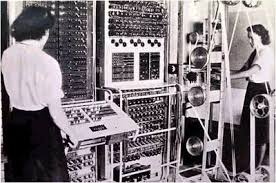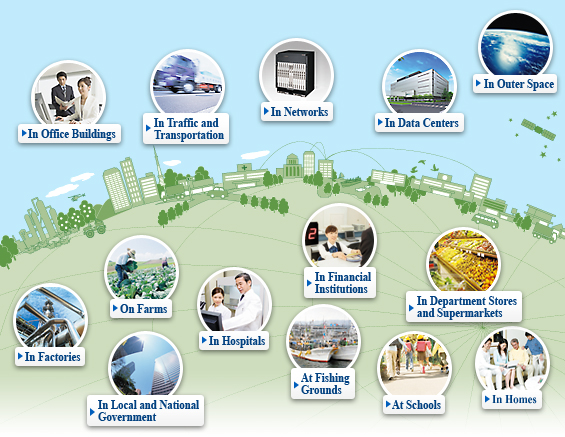INFORMATION TECHNOLOGY AND INFORMATION TECHNOLOGY CONCEPT
I have learnt about Information Technology. It is a term that encompasses all forms of technology used to creat, store,exchange and use information in its various forms.
- Information Technology architecture is map or plan of the information assets in an organization. Integrates entire organization's business needs for information.
- Infrastructure and application is talking about Information technology infrastructur. Including, facilities, IT components, IT services and IT personnel that support an entire organization.
As we can see in this
picture.
Information technology infrastructure:
is the integrated framework upon which digital networks operate. This infrastructure includes data centers, computers, computer networks, Database Management devices, and a regulatory system.
we use infrastructure refers to interconnecting hardware and software and not to computers and other devices that are interconnected. However, to some information technology users, infrastructure is viewed as everything that supports the flow and processing of information.
Infrastructure companies play a significant part in evolving the Internet, both in terms of where the interrconnections are placed and made accessible and in terms of how much information can be carried how quickly.In addition, ICT has changed society today. For example, Science, Healthcare, education, banking, business and government.
Session 1 INFORMATION SYSTEMS
It is a combination of hardware, software, infrastructure and trained personnel organized ot facilitate planning, control, coordination and decision making in an organization.
- In this session i have understood a lot about what is the Information system. And here are function of information system do.
- To help users to become information competent, that means find it easy to organize their information, search for information, analyse their information and using old information to create new information
salji
Friday 22 February 2013
SESSION 1 ( LO2)
Wednesday 20 February 2013
SESSION 1 (LO1)

EXPLAIN THE DEFFERENCE BETWEEN DATA AND INFORMATION, THE ECONOMICS AND PROBLEMS ASSOCIATED WITH INFORMATION MANAGEMENT
Asalamualaikum everyboday and my good lecturer.
Actually, i have not studied about the topic one, but i try to read all the side show that i get from my lecturer to understand and try to make a summaries and reflect by what have i learned with my lecturer in her office and by myself.
Actually, i have not studied about the topic one, but i try to read all the side show that i get from my lecturer to understand and try to make a summaries and reflect by what have i learned with my lecturer in her office and by myself.
Explain the different between Data and Information
 Data is raw,unorganized facts that need to be processed. Date can be something simple and seemingly random and useless until it is organized.
Data is raw,unorganized facts that need to be processed. Date can be something simple and seemingly random and useless until it is organized.For example: Statistics, numbers, characters, images, vedios and so on that that get from internet, camera, pindrave, memory cards and so on..
Information is interpreted data. When data is processed, organized, struture or presented in a given context so as to make it useful and have meaningful.
For example, my name is Ly zahry. This sentence is have meaningful that make you all can understand, it calls information.
On week 2 we learnt more about information management. Our lecturer explain what is information management and so on.
Next we continue our lesson base on common information management problems. It has some problem such as:
- Large number pf disparate information management systems.
- Little integration or coordination between information systems
- Range of legacy system requiring upgrading or replacement.
- etc
What is the Computer?
Computer is a programmable machine. This means it can execute a programmed list of instructions and respond to new instructions that it is given.
We can use computer to do our works. Such as, we can use it for typing, edit or design picture or photos, counting and all of things more that we can use it to to.

Basic operation that a Compute can perform
- Input
- Processing
- Output
- Storage and another one is communication
The first one, you input the datas into the computer. Then, the computer will be processed those Datas. when all the datas have already processed and have meaningful it will become to information.
example: you input your photos which have in your memory card into camputer. then, that photo will be processed by using any program that have in the computer, such as, photoshop and so on. finally, when you output by print out your that photo, it calls information.

INFORMATION MANAGEMENT


INFORMATION TECHNOLOGY
I have learnt about Information Technology. It is a term that encompasses all forms of technology used to creat, store,exchange and use information in its various forms.

As we can see in this
picture.

Information technology infrastructure:
is the integrated framework upon which digital networks operate. This infrastructure includes data centers, computers, computer networks, Database Management devices, and a regulatory system.
we use infrastructure refers to interconnecting hardware and software and not to computers and other devices that are interconnected. However, to some information technology users, infrastructure is viewed as everything that supports the flow and processing of information.
Infrastructure companies play a significant part in evolving the Internet, both in terms of where the interrconnections are placed and made accessible and in terms of how much information can be carried how quickly.
EVOLUTION OF COMPUTER
My slide
There fifth evolution of computer
The first
Evolution of Computer
1. First Generation( 1949-1950): Vaccum tube
My slide
There fifth evolution of computer
The first
Evolution of Computer
1. First Generation( 1949-1950): Vaccum tube
- at that time there were electronic computer: ENIAC(1945)
- electronic Numerical integrator and computers. and maybe around 18000 vaccum tubes were used to build ENIAC and it was programmed by manually setting swiches.
- that electronic computer were used by US army to calculate and designed hydrogen Bomb.
2. Second generation (1950 to 1964) Transistors.
- william shockley, john Bardeen and walter brattain who invent the Transistor. and vaccum tubes have been replaced by transistors at that time.
- the most computer was IBM 1401. and it used in high level languages( cobol: for all common business- oriented language and for transtlater.
3. The third generation ( 1946-1974) Intergrated circuits (IC)
many years later, the technoloy more developed and user started use OS, keyboard and
monitor.

monitor.

4. Fourth generation( 1974 to present) VLST/ ULST.
fourth generation was the time that computers are the modern computers.
It took only 55 years for the 4 generations to evolve. The growth of the computer industry developed technologies of computer inventions. There are many types of computer models such as: Apple Macintosh Dell IBM Ace. Then in 1971, Intel created the first microprocessor.


1976, Steve Jobs built the first Apple computer. Then, in 1981, IBM introduces its first personal computer. During the fourth generations hardware technology such as silicone chips, microprocessor and storage devices were invented. A microprocessor specialized chip which is developed for computer memory and logic. The microprocessor is a large scale integrated circuit which contained thousands of transistor The transistor on this chip are capable of performing all of the function of a computer’s central processing unit.
Fifth generation( Now and the future)




1976, Steve Jobs built the first Apple computer. Then, in 1981, IBM introduces its first personal computer. During the fourth generations hardware technology such as silicone chips, microprocessor and storage devices were invented. A microprocessor specialized chip which is developed for computer memory and logic. The microprocessor is a large scale integrated circuit which contained thousands of transistor The transistor on this chip are capable of performing all of the function of a computer’s central processing unit.
Fifth generation( Now and the future)
- Based on artificail intelligence-computers can think,reason and learn.
- Primary means of input-voice and touch
- CATEGORIES OF COMPUTERS
- there are six categories based on size , capability and price
- Embedded computers
- Mobile devices/computers
- personal computers
- Midrange servers
- Mainframes
- supercomputers
- Advantages Computers became 100 times smaller than ENIAC Gain in speed, reliability and storage capacity Personal and software industry boomed
Integrated circuits( Microchip)




- VLSI= very large-scale integration
- ULSI= ultra large scale integration
ensured that milions of components could be fit into a small chip.
last monday my lecturer have given some exercises for each group and she asked us to set in group for discuss and answer all the question that i have been given. And what that i can understand about
IMS, DIS..
last monday my lecturer have given some exercises for each group and she asked us to set in group for discuss and answer all the question that i have been given. And what that i can understand about
IMS, DIS..
INFORMATION MANAGEMENT
- Information management(IM) is general terms that refers to managing any kind of information.
- It is the collection and management of information from one or more source and the distribution of that information to one or more audiences

- Here are six terms of technology information management encompasses systems. Such as,
- Web content management(CM)
- Document management (DM)
- Records management(RM)
- Digital asset management(DAM)
- Learning management systems(LM)
- Learning content management systems(LCM)
INFORMATION TECHNOLOGY
I have learnt about Information Technology. It is a term that encompasses all forms of technology used to creat, store,exchange and use information in its various forms.
- And Information Technology architecture is map or plan of the information assets in an organization. Integrates entire organization's business needs for information.
- Infrastructure and application is talking about Information technology infrastructur. Including, facilities, IT components, IT services and IT personnel that support an entire organization.

As we can see in this
picture.

Information technology infrastructure:
is the integrated framework upon which digital networks operate. This infrastructure includes data centers, computers, computer networks, Database Management devices, and a regulatory system.
we use infrastructure refers to interconnecting hardware and software and not to computers and other devices that are interconnected. However, to some information technology users, infrastructure is viewed as everything that supports the flow and processing of information.
Infrastructure companies play a significant part in evolving the Internet, both in terms of where the interrconnections are placed and made accessible and in terms of how much information can be carried how quickly.
In addition, ICT has changed society today. For example, Science, Healthcare, education, banking, business and government.


Session 1 INFORMATION SYSTEMS
It is a combination of hardware, software, infrastructure and trained personnel organized ot facilitate planning, control, coordination and decision making in an organization.



It is a combination of hardware, software, infrastructure and trained personnel organized ot facilitate planning, control, coordination and decision making in an organization.
- In this session i have understood a lot about what is the Information system. And here are function of information system do.
- To help users to become information competent, that means find it easy to organize their information, search for information, analyses their information and using old information to create new information
There are many Types of Information System ( IS)

Subscribe to:
Posts (Atom)





